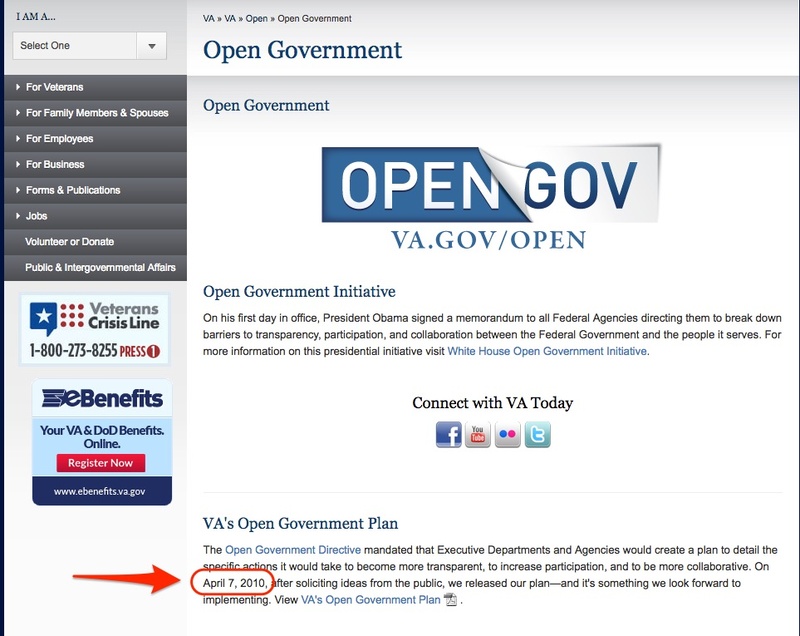The Department of Veterans Affairs needs a new Open Government Plan

The care and support that our nation provides to veterans merits all of the transparency and accountability the federal government can bring to bear. That’s why the absence of a new open government plan from the Department of Veterans Affairs (VA) over the past six years is not only an egregious flouting of President Barack Obama’s 2009 Open Government Directive, but a failure in governance that calls into question whether such plans accurately reflect the priorities and mission of agencies.
These open government plans represent one of the primary vehicles for ensuring that public commitments to open government are part of the next administration. It is more critical than ever for all agencies to not only publish them, but to deliver the progress reports and frank self-assessment that the guidance from the White House requested this summer. Veterans and the public deserve a new 2016 Open Government Plan from the VA that includes a flagship initiative to publish performance data next to customer service data from the men and women it serves.
The VA has an important story to tell, too, which is what makes its failure to publish a plan since 2010 so frustrating. Despite well-documented scandals and mismanagement, veteran-facing digital services are improving. Visit Vets.gov on your smartphone to see what we mean.
The trouble is that the agency itself is not only not taking sufficient proactive steps to disclose open data about the performance of its services and hospital, but also failing to hold itself publicly accountable for not doing so.
These failures are not an abstraction. When President Obama was asked about failures at the VA by a grief-stricken widow at the CNN Town Hall this week, he talked about the steps that the federal government had taken to improve the VA. He told her that if suicidal veterans call a crisis prevention hotline, someone will be there to pick up. A recent report by the General Accountability Office (GAO) in May 2016, however, showed delays in response time.
GAO found that the Department of Veterans Affairs (VA) did not meet its call response time goals for the Veterans Crisis Line (VCL), although extended call wait times were not common. VA’s goal is to answer 90 percent of VCL calls at the VCL primary center within 30 seconds. Currently, calls not answered within 30 seconds route to VCL backup call centers; however, for 5 months of fiscal year 2015, calls were routed to VCL backup call centers after 60 seconds. VA officials told GAO that VA data show about 65 to 75 percent of VCL calls were answered at the VCL primary center in fiscal year 2015 within either 30 or 60 seconds. GAO’s covert testing in July and August 2015 confirms VA’s data. Specifically, 119 covert test calls show that an estimated 73 percent of calls made during this period were answered within 30 seconds. GAO also estimates that 99 percent of all VCL calls during this period were answered within 120 seconds. GAO also covertly tested the VCL’s text messaging services and found that 4 of 14 GAO test text messages did not receive responses.
Investigators found something even more troubling: Neither the agency nor the provider of the service was measuring service-level quality on an ongoing basis.
That’s unacceptable. No matter what the rate of veterans suicide is, anyone who is in need should be able to get help – and the public should expect accountability if no one picks up the phone within 30 seconds or responds to a text.
VA officials said they do not monitor or test the timeliness and performance of the VCL text message system and instead rely solely on the VCL’s text messaging provider for these functions. VA officials told GAO that the provider had not reported any issues with the system, but the provider told GAO that routine testing of the VCL system is not conducted. Without routinely testing its text messaging system or ensuring that its provider does so, VA cannot identify limitations to this service.
The VA should be auditing and monitoring the performance of veteran-facing services – as it committed to do in a response to the GAO report. This data should be released in a structured and easy-to-use format so that veterans groups, veterans, veterans families, the media, Congress and the general public can see how well these programs are performing.
Predictive data analytics can then be applied to find where and when services need to be improved, in the same way that it’s used to save lives, taxpayer dollars, and protect national security. That same approach can and should be applied to every veteran-facing service.
We commend the U.S. Digital Service and the public servants at the VA itself for their ongoing efforts to use technology to improve a sprawling system. What’s missing now is action from the White House and the department to publish an open government plan that commits to being transparent and accountable about the quality of services and access to those services across the system throughout the United States, from hospitals to call centers to clinics.
On that count, we call on Congress, the VA and the Department of Health and Human services to restore hospital performance data. A blank website at hospitalcompare.va.gov is a national embarrassment. Of the 733 datasets from the VA on Data.gov, the five related to healthcare date back to 2009. That’s not good enough.
Delivering on open government is not an abstraction. It’s a moral imperative. It’s what our veterans and their families deserve. It’s what open government should deliver as a core aspect of how our government is accountable to the public.

